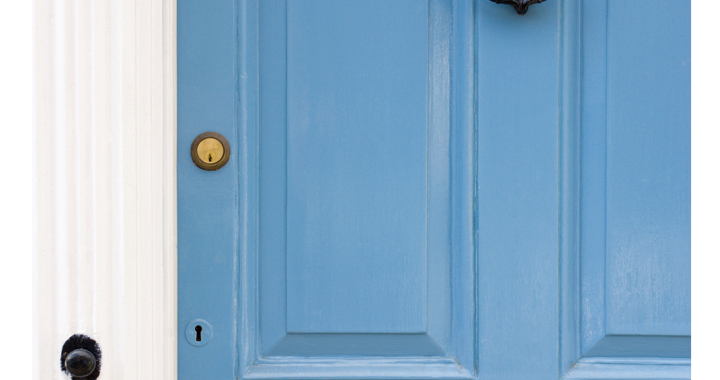
Yes. This is probably a wooden door. But we bought the picture, so we’re going to use it! Just use your imagination…
Painting a steel door is one of those projects that can make a big impact on the exterior appearance of your home. And if you do the project the right way, you’ll be enjoying that color for years to come.
If you’re thinking about sprucing up your front door any time soon, follow these tips and steps to make sure the project goes as easily as possible:
- REMOVE THE DOOR and THE WEATHER STRIPPING: If possible, you’ll have your best success if you can completely remove the door from the frame and set it in your garage or your basement on saw horses. If you can’t remove the door, don’t sweat it–you can still do a good job, though you’ll need to be a little more cautious with paint runs, etc. Also, many doors allow you to remove the weather stripping. This is ideal. Remove it (paying attention to how it will go back on) and store it somewhere safe.
- REMOVE THE HARDWARE: Whether or not you can remove the door from the frame, the next step is to remove the hardware. Remove the hinges, the door knobs, and the kick plates. You can paint around them or tape them off, but leaving them on makes all the subsequent steps more complicated and more time consuming. So, remove them if at all possible!
- SURFACE PREP: As with any painting project, failure or success is usually determined before you even open a can of paint. If you’re painting over a previously painted door, you need to make sure that you sand and scrape at all the paint to ensure that what remains on the door is stuck down well. Sand the door with 120 grit paper (you’re lightly sanding it–not trying to leave visible grooves). And then, after sanding and scraping, wash the door down well with a solution of TSP (TriSodium Phosphate). Quick Tip: When using the TSP, scrub the door down with a 3M Scotchbrite pad (a little green scrubby pad you might use on dishes). This will serve to dull and etch your previously painted surface and will aid with the bonding of the new paint!
- PRIME (if necessary): After you’ve sanded and washed the surface, you should prime any bare metal spots with RepcoLite’s 449 Grey Metal Primer. This is an oil-based, rust-inhibitive primer, that’s perfectly suited for these situations.
- BRUSH or ROLL YOUR DOOR: Either using a high-quality brush or a small, quality 4″ or 7″ roller, apply your paint to the door. We recommend applying RepcoLite’s Endura Acrylic Latex Paint for the most durable, longest lasting finish. Work evenly and quickly, starting with the inserts and then finishing up with the remaining flat surfaces of the door. Apply coats as needed.
- LET IT DRY and RE-INSTALL: Let the door dry at least 8 – 12 hours (longer if possible) and carefully re-install it. UNDERSTAND: Latex paint will dry to the touch in a matter of hours, but it doesn’t reach it’s full hardness for about 30 days. You don’t need to leave the door off the hinges for 30 days, but keep in mind that just because it’s “dry” that doesn’t mean it’s as strong or durable as it’s going to be . . . so go easy!
- RE-INSTALL WEATHER STRIPPING LATER: If you can leave the weather stripping off for 10 – 30 days, that’d be in your best interests! As mentioned earlier, the latex paints will dry quickly, but if you close the door and press it against the weather stripping too soon, it’s entirely possible that the paint will peel around the edges when you next open the door! If you can leave that stripping off for a couple weeks or so before re-installing it, you’ll minimize your risks.
FINAL TIPS and PARTING THOUGHTS
- COLOR MATTERS: Dark colors fade quickly. Red can be especially bad. Also, reds can cover poorly.
- NO SHORTCUTS: One of the worst things you could do when painting a door is try to make a coat of paint cover in 1 coat when it probably needs 2 or 3. The best advice we can give you on this one is to apply EVEN coats. If you’re color needs 2 – 3 coats of paint, then resign yourself to applying 2 – 3 coats of paint. If you try to make it cover by applying it too heavily, you will have all sorts of problems on your hands. The paint will run and sag; it won’t cure or dry well and you’ll find it sticking to your weather stripping and causing all sorts of other problems! So, don’t rush it.
- GIVE IT TIME TO DRY: Latex paints dry to the touch very quickly, but don’t let that fool you into applying too many coats too soon. Apply a coat and let it dry for an hour or two before trying the second one. Sometimes you could apply those coats as quickly as 15 – 20 minutes after each other (it dries that fast), but in the end, you’ll only run into problems. So give it the dry time the can recommends.
- LATEX IS BETTER THAN OIL: Latex Acrylics (like RepcoLite’s Endura) will outperform oil based products. They’ll hold their color better and they’ll endure the constant expansion and contraction a steel door experiences much better as well.
- PAINT IN THE SHADE: Paint when the sun isn’t directly on the door. And ideally, paint before or long after the door’s been exposed to the sun. Steel doors will heat up significantly on a summer day and if you get on it and start painting too soon, or when it’s too hot, you’ll have trouble with your latex paint. It will dry much too quickly and you’ll end up with streaks and roller marks.
I could go on and on, but you get the idea. This is a project that usually can be accomplished in just a few hours. It’s not complicated–and if you take the steps we’ve outlined (and check with any RepcoLite store for more information if you have questions) you’ll be fine!

